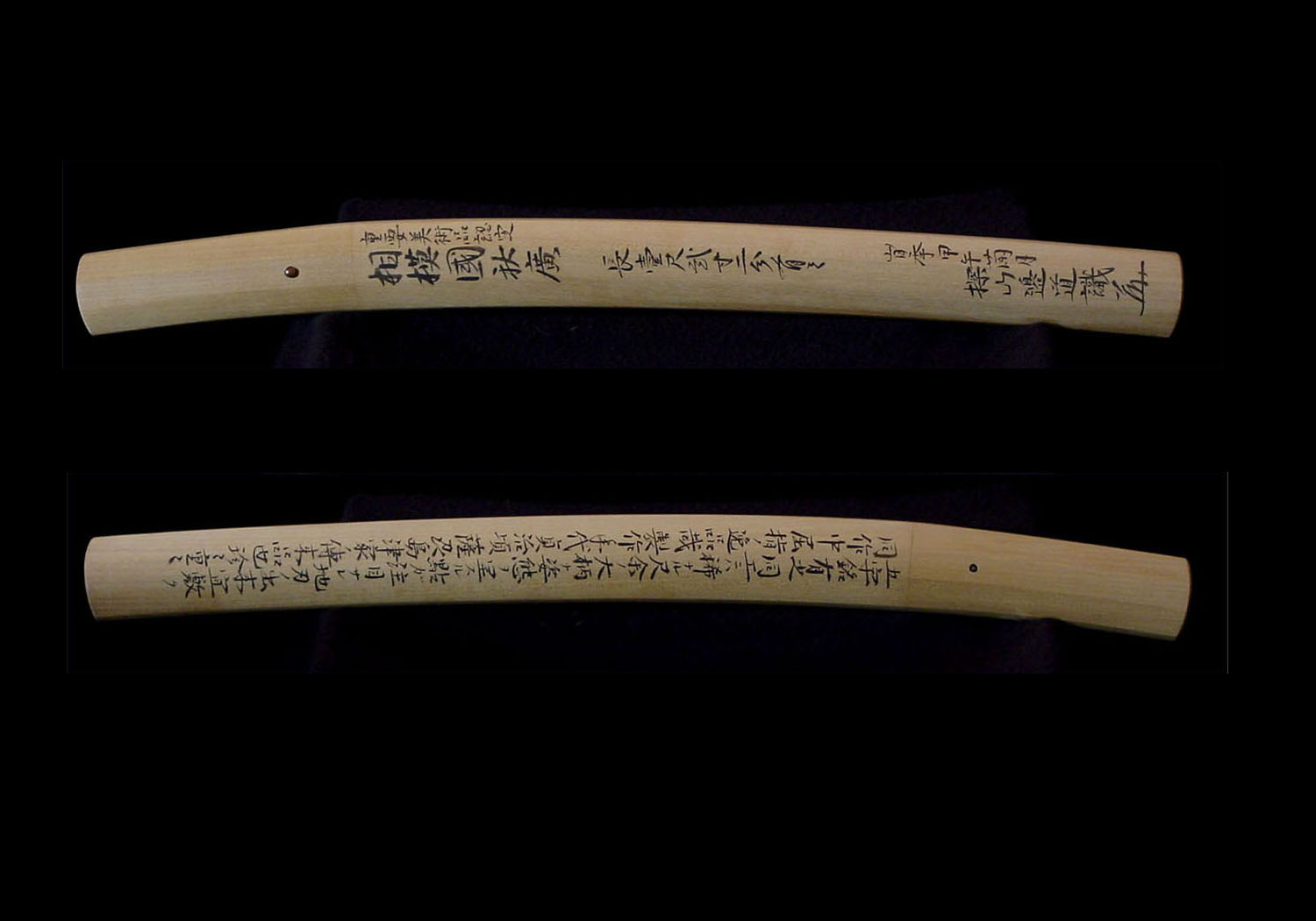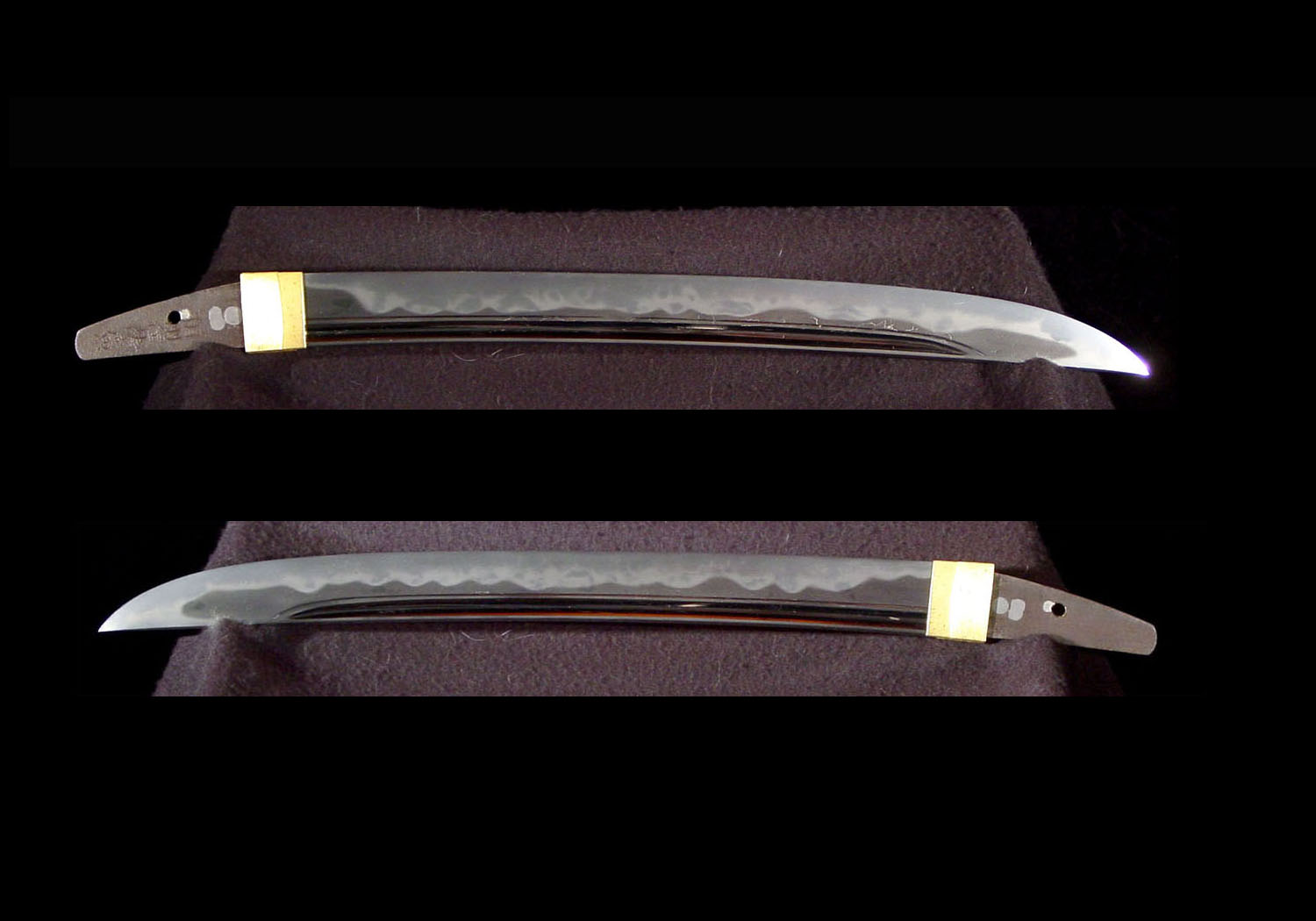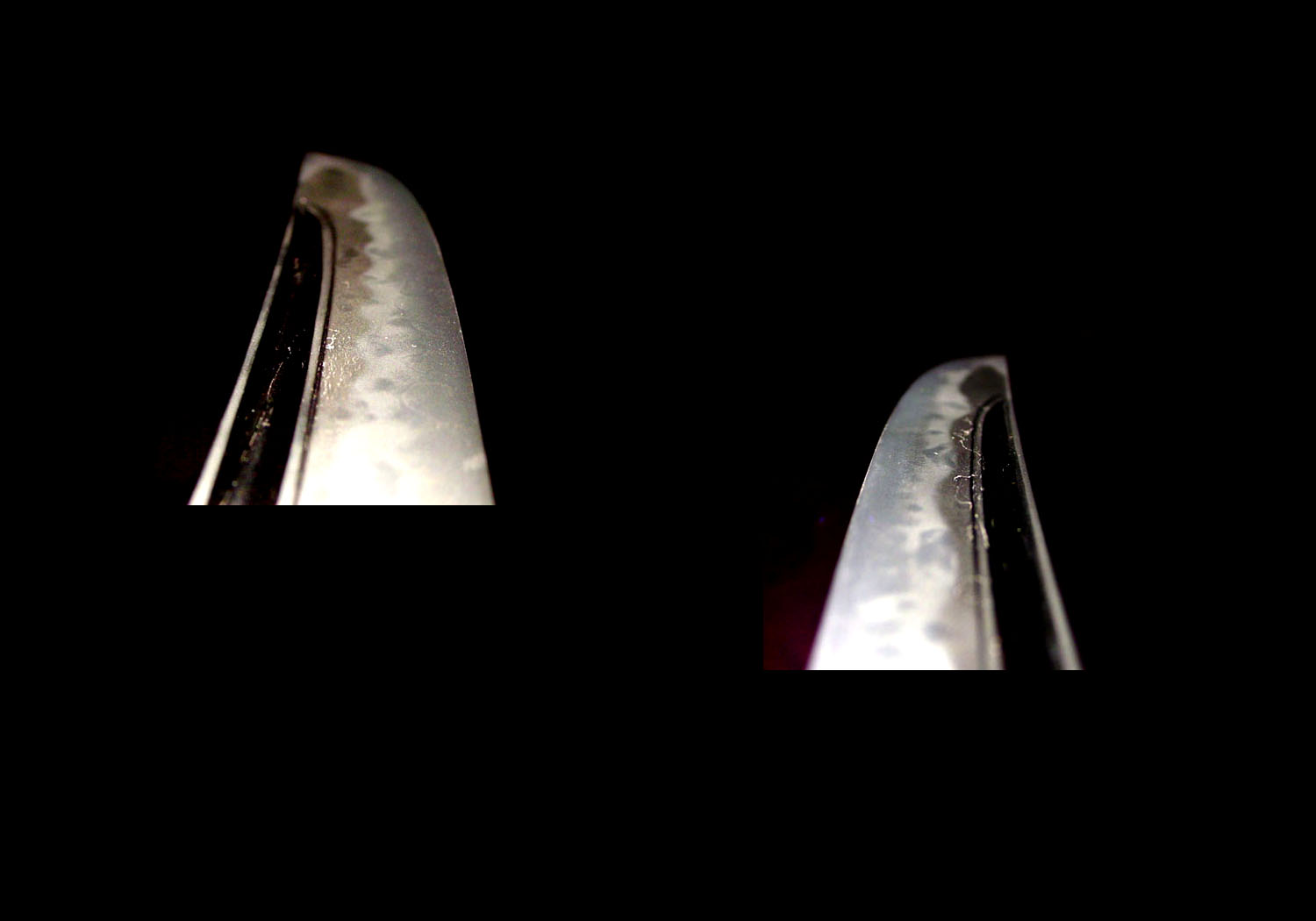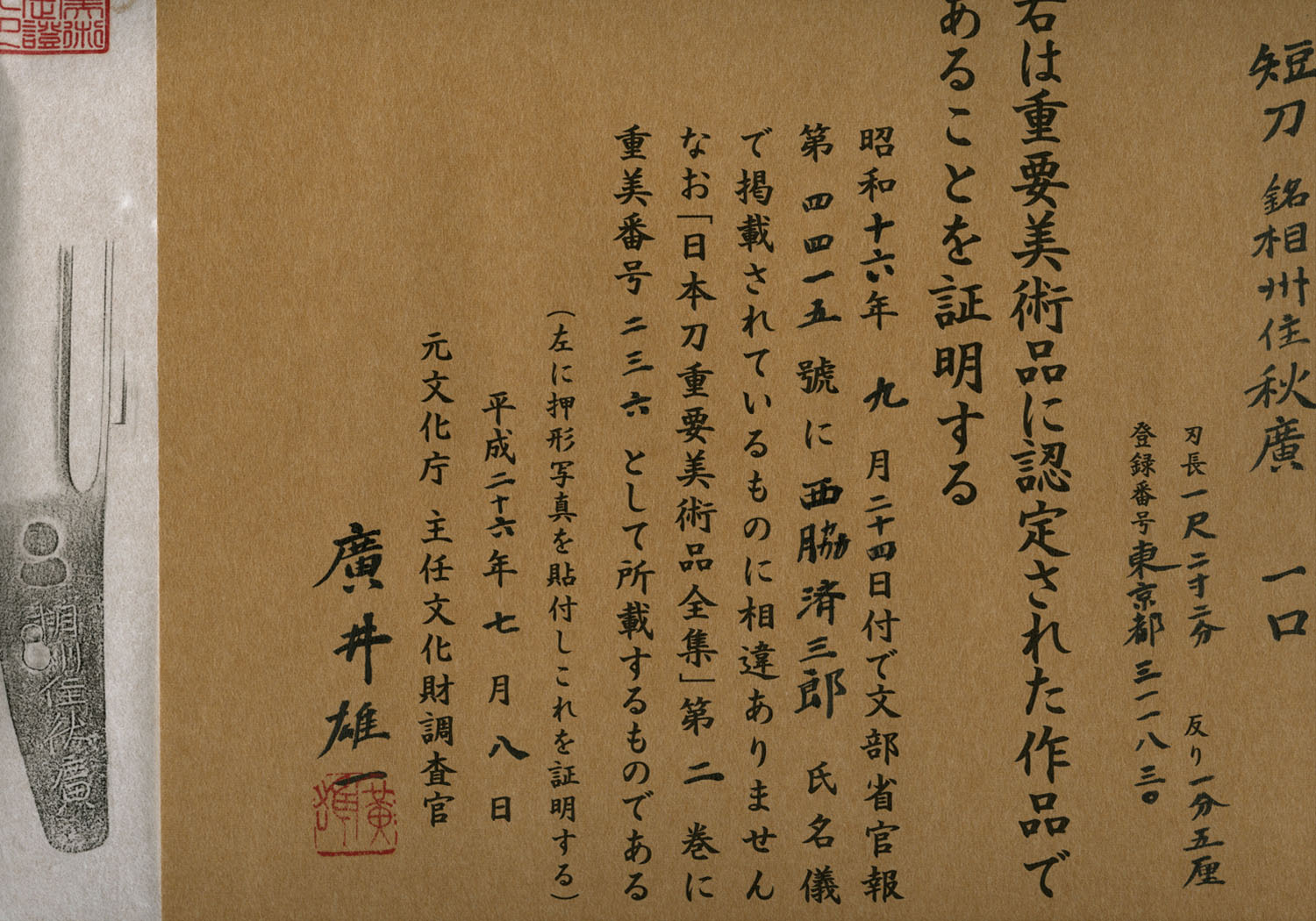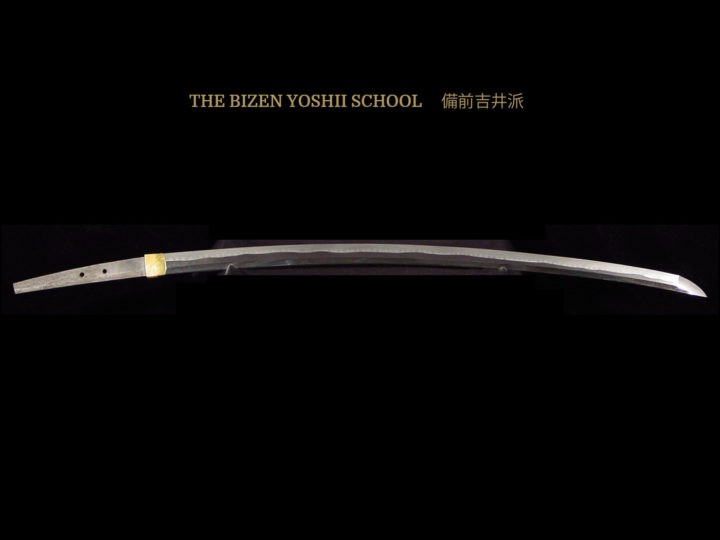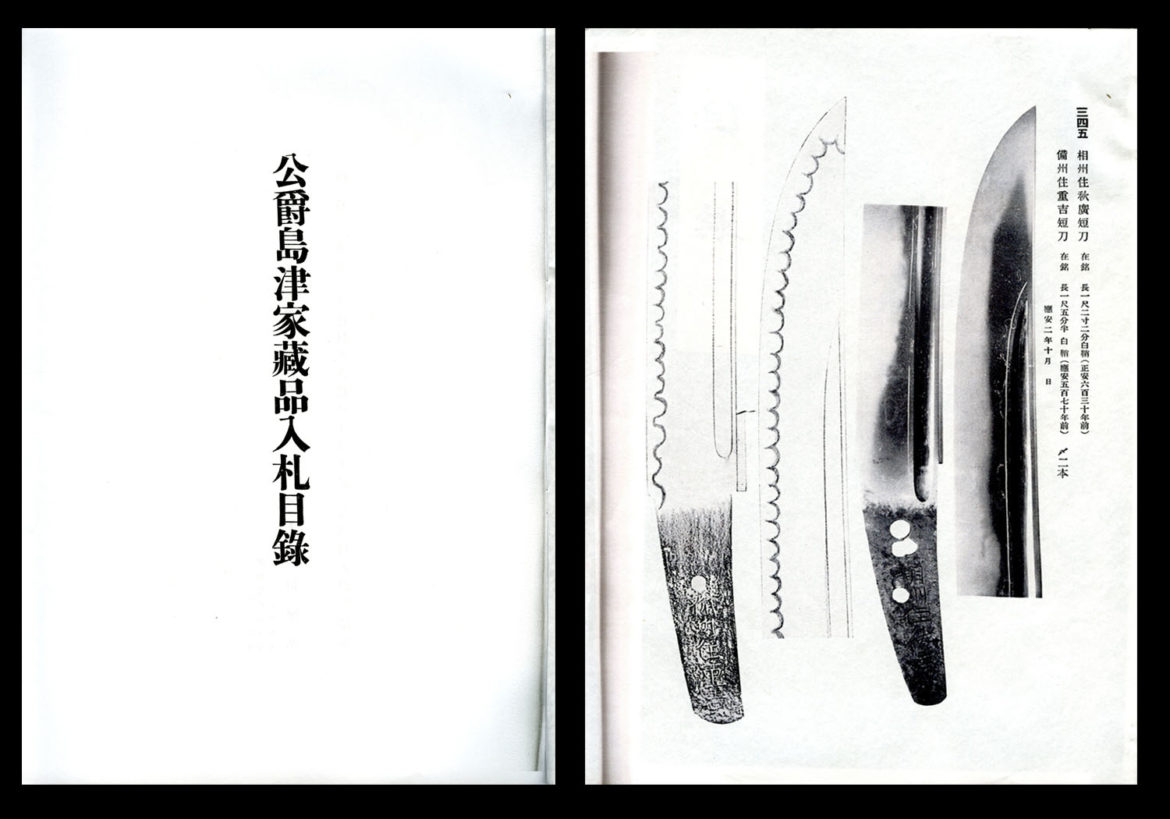
In the year 1185 after his victory at the battle of Dan-no-ura, Minamoto Yoritomo decided to move the center of Government from Kyoto to a small fishing village in the eastern part of the country. The name of that village was Kamakura and thus was ushered in the Kamakura era of Japanese history. This was the first true military government of Japan. It should be noted, however, that through the first three generations of the Minamoto Ke (family), the structure of the Kamakura government did little more than follow in the footsteps of the old Heian government of Kyoto. It was not until the Hôjô Ke became Bakufu Shikken (Regents) and for all intents and purposes took control of the government that the true Kamakura style took effect.
What we think of as being the “Kamakura style,” is that of a rugged and masculine style (as opposed to the court nobles of Kyoto). Eastern Samurai were rustic warriors who were masculine, big, and imposing. During the early period of the Kamakura era, sword production remained centered in Yamashiro and Bizen with their graceful tachi imported to Kamakura. During the time of the third Minamoto Shôgun (Sanetomo), the Hôjô Shikken (Regent) replaced Minamoto Sanetomo and declared himself Shôgun.
Around this time, well-known sword smiths were called to Kamakura and instructed to make the new capital the base of their sword manufacturing. They were instructed to make swords that were excellent in both beauty and practicality. They wanted swords that were big and imposing reflective of the bushi of the eastern provinces. Also, the lesson of the ineffectiveness of the older slender tachi against the hard leather armor of the Mongol invaders was a driving force for these bigger and more powerful swords.
We can break down the evolution of the Sôshû tradition into five periods. We will only concern ourselves with the first three periods for this paper as the fourth and fifth period were during the Muromachi era. What we call the first period of the Sôshû tradition began with the relocation of famous smiths to Kamakura at the request of the Bakufu.
From Yamashiro came Kunitsuna (国綱), Shintogo Kunimitsu (新藤五国光), Kunihiro (国広), and Kunishige (国重). From Bizen came the Fukuoka Ichimonji (福岡一文字) smiths, Sukezane (助真) and Suketsuna (助綱). Shintogo Kunimitsu (新藤五国光) is credited with being the founder of the Sôshû tradition. He was also the first smith who clearly recorded in his mei the inscription that he lived in Kamakura.
There is no absolute delineation between periods of the evolution of the Sôshû school and Shintogo Kunimitsu (新藤五国光) carries us into the beginning of the second period. He is joined at this point in time by such notable smiths as Yukimitsu (行光), Masamune (正宗), and Sadamune (貞宗). This second period was immediately following the Mongol invasion. There was a feeling that the swords of the Heian Jidai and the beginning of the Kamakura Jidai did not possess sufficient strength for what was then considered to be “modern warfare”. Therefore, they were viewed as being “treasure swords” and were stored away as family treasures with new, stronger and more powerful swords being sought. Thus, we see the development of the wider, longer, and generally more massive swords of the Nanbokuchô coming into vogue. In fact, some references surmise that during the Nanbokuchô era, the swords made by the Sôshû smiths, which were the Shinshintô blades of that time, comprised the greater half of the tachi that were used by the bushi at that time. Perhaps that is the reason that products of the Sôshû Kaji are so few now as compared to the other Koto schools. They were used in warfare and were made in much smaller quantities than the mass produced remaining swords of the Muromachi era.
We must also include other important smiths in this second period of Sôshû sword production. Certainly, we can include the Masamune Jittetsu (ten famous students of Masamune). They are generally considered to have been Rai Kunitsugu (来国次) of Yamashiro, Hasebe Kunishige (長谷部国重), Shizu Kaneuji (志津兼氏) and Kaneshige (金重) of Mino, Norishige (則重) and Gô Yoshihiro (郷義弘) of Etchû, Kanemitsu (兼光) and Nagayoshi (長義) of Bizen, Naotsuna (直綱) of Iwami, and Chikuzen Samonji (筑前左文字).
The Nanbokuchô era is generally considered to have started around Kenmu (1334-1336) and ended in Meitoku (1390-1394). It was in the later part of this period that we enter what is known as the third period of Sôshû sword production. This saw the coming of Hiromitsu (広光) and Akihiro (秋広). For many years Akihiro (秋広) was thought to have been the sempai (predecessor) of Hiromitsu (広光). Based on the nenki of extant swords, however, he appears to have been a little later but contemporary with Hiromitsu (広光). There is very little in the style of workmanship to differentiate between these two smiths. What differences do exist are subtle.
The following are the basic characteristics of these two smiths with Akihiro’s (秋広) minor differences noted.
SUGATA: Tachi are few and of those that remain, zaimei swords are extremely rare. This is due in part to the excessive size of these katana and the invariable shortening over the years with the loss of the mei. They have the typical sugata of the Nanbokuchô era with shallow sori, wide mihaba, thin kasane with little, if any, hiraniku. The kissaki will be long giving a very sturdy and strong appearance. As stated, most are o-suriage mumei.
As for ko-wakizashi, most are about 1 shaku and 1 or 2 sun in length (33-37 cm). Of course, some will be larger. They are wide with slight hiraniku, thin kasane, slight saki sori, and are mitsu mune. They are hira-zukuri in shape.
Tantô will also be found with a nagasa of less than 1 shaku. The overall sugata will mirror that of the o-tantô or ko-wakizashi described above. It should be noted that the tantô of Hiromitsu (広光) is normally over 30 cm, but the tantô of Akihiro (秋広) never exceed 30 cm. This difference in tantô length tends to enforce the belief that Akihiro (秋広) worked slightly later than Hiromitsu (広光).
JITETSU: The ji-hada will be well-forged itame with mokume. There will usually be areas of nagare-hada (flowing). Thick ji-nie and chikei together with tobi-yaki, yubashiri, and mune yaki are found.
HAMON: Overall it is ô-midare that is kuzure (crumbled) with coarse nie. There are many pieces in which kinsuji and inazuma are particularly intense, nie will split the sunagashi by the ha, and they are hadatachi. The tobiyaki condition is abundant and it becomes the hitatsura style.
One of the differences between Hiromitsu (広光) and Akihiro is that the hitatsura of Akihiro (秋広) tends to be active vertically, while the hitatsura of Hiromitsu (広光) tends to be wider along the horizontal axis. Also Hiromitsu (広光) tempers hitatsura mixed with large and round chôji, meanwhile Akihiro (秋広) does it in smaller patterns and it is mixed with squarish gunome-midare and togari-ba. Also the hamon of Akihiro (秋広) will mix in dango-chôji (dumpling shaped chôji) while, as noted, Hiromitsu’s (広光) chôji tend to be round.
BÔSHI: The bôshi will be a continuation of the hamon in midare-komi with nie kuzure and the kaeri will be deep. Some of the bôshi will enter at about the area just below the yokote becoming an ichimai bôshi. Often, especially on tantô and wakizashi, the bôshi will become kaen and many hakikake will be seen.
NAKAGO: As noted, most of the tachi have been shortened and their original nakago have been lost. On wakizashi and tantô, the nakago will be short and tanagobara in shape. The nakago jiri will be kuri-jiri and the yasurimei will be kiri.
MEI: Akihiro (秋広) generally inscribed Sôshû Ju Akihiro (相州住秋広). One important thing to check when judging authenticity is that without exception the genuine mei of Akihiro (秋広) has the first stroke of the kanji character, “Hiro” (広) struck horizontally as opposed to that of Hiromitsu (広光) which is always struck vertically. As far as nengo are concerned, during certain periods Akihiro (秋広) only inscribed the historical era and its number omitting the kanji for year, month, and day. As an example, one of his wakizashi reads Eiwa 1. This means the first year of Eiwa and nothing more. At other times, like during the Enbun era, he inscribed the full year, month and day on his nakago. During the Oan era, there are examples with no date at all. From the Eiwa era, however, his works are dated without exception.
KANTEI POINTS: The sugata is wide with a thin kasane and little or no hira-niku. These traits point to the Nanbokucho era. The profuse use of choji, midare, and ji-nie creating a hitatsura hamon points to the Soshu school. The two most representative smiths of this school at that time were Hiromitsu or Akihiro. Looking closely at the shape of the chôji one sees the more irregular shaped (dango chôji) of Akihiro rather than the roundish chôji of Hiromitsu. The lack of a strong saki-sori and the strength and depth of the hitatsura would rule out the later smiths of the Muromachi era. Also, the lack of any straight grain in the areas close to the mune and the ha would rule out the Hasebe school.
AN IMPORTANT BLADE BY AKIHIRO 秋広
The photos below are of an important and well-known tantô or ko-wakizashi by Soshu Akihiro (相州秋広). This sword was a treasure for generations of Shimazu (島津) Daimyo of the Satsuma Kei (薩摩系) in Kyushu. In May of 1928 this sword was sold in auction when the descendants of the Shimazu (島津) Daimyo family sold their family treasures including their swords. On September 24, 1941, it was given the designation of Juyo Bijitsuhin (重要美実品) which means Important Cultural Property.
At the end of World War Two during the chaos of the beginning of the occupation an edict was issued by the occupation forces that all swords were to be considered weapons and as such must be turned in to the police. Many of these swords were destroyed and many more found their way to the West as war souvenirs. Also, swords were taken from Temples and Shrines as war trophies and made their way out of Japan either surreptitiously or with the knowledge of the occupation forces.
After the distinction between swords as weapons and swords as art and historical objects was understood, a list of missing National Treasure (Kokuho) and Important Cultural Object (Juyo Bijistuhin) blades was compiled. There were fourteen missing Kokuho and twenty-five missing Juyo Bijitsuhin blades. This wakizashi by Akihiro is listed as number eighteen among the missing Juyo Bijitsuhin blades. The last record of it in Japan shows that on October 5, 1945, the then owner submitted this blade to the Kosegaya Police of Kosegaya City in Niigata Prefecture.
After acquiring this blade in the USA, I returned it to Japan for restoration and replacement of the missing and lost original Juyo Bijitsuhin (重要美実品) designation certificate. I also requested permission to properly and legally export it from Japan. After about a year, permission to export it was granted so now it can legally be owned outside of Japan. It should be noted that without such permission, blades of this designation are not allowed leave Japan.
This blade is a superb example of the work of Akihiro, one of the most famous of the Soshu smiths. It has a cutting edge of 14 9/16 inches or about 37 cm. It has a moto-haba of 1.30 inches or 3.3 cm and a saki-haba of 1.08 inches or 2.75 cm. The characteristics listed above accurately describe this blade. It is now in fresh Japanese polish, a new shirasaya, and a solid gold habaki. Blades of this importance and quality come up for sale very rarely in Japan and almost never outside of Japan.

